A layman’s guide to media reform: what you need to know and what happens next
The Federal government last week confirmed the details of its media reform package. With the Bill now before Parliament Nic Christensen looks at the question of what happens next and where the potential landmines for the package are.
 Media reform has been on the agenda for much of the past 12 months but now that we have a bill before Parliament let’s look at the key some issues likely to dominate the headlines in the months to come:
Media reform has been on the agenda for much of the past 12 months but now that we have a bill before Parliament let’s look at the key some issues likely to dominate the headlines in the months to come:
- What’s in the Coalition media reform package?
There are three parts to the media reform package proposed by Communications Minister Mitch Fifeld last week. Those components are: abolishing the reach rule; the two out of three rule, and the creation of “new and higher” local content protections.
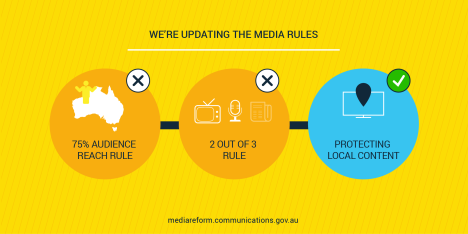
Source: Department of Communications.
THE REACH RULE
Put simply, this is a law in the Broadcasting Services Act of 1992 that decrees no TV station can reach more than 75% of the population via terrestrial broadcast.
It was created in an era well before the internet and has moved to the forefront in the past nine months after Seven, and, subsequently, Nine, announced they would begin live-streaming their TV channel content online across the country.
The live-streaming move has angered many of the regional TV players who, even prior to the move, had been lobbying for removing the reach rule (among other changes) arguing the 1992 law was “archaic”.
This move now, basically, makes the reach rule redundant, and there is general industry and political consensus about its abolition.
THE TWO OF THREE RULE
The two-out-of-three rule was established by the Keating Government in 1986 and was designed to prevent a single person or company from controlling more than two out of three media platforms – commercial radio, commercial television and newspaper – in the same radio licence area.
As Tim Dwyer notes in The Conversation, while there is acceptance around abolition of the reach rule, two out of three is more contentious as the law helps ensure that no one player dominates a market.
That’s not to say it’s the only law protecting media diversity (other laws such as the “one to a market” rule for TV, the “two to a market” rule for radio, and the restrictions on the number of independently-controlled media voices of five in a metro area or four in a regional area – “the 5/4 voices rule” – will continue to exist, not to mention there are also directorship limits associated with the ‘one to a market TV and ‘two to a market’ radio rules.
But what is clear from the outset is that this is amongst the most contentious parts of the reform package (more on this later).
NEW LOCAL CONTENT PROTECTIONS
The local content provisions have come, in part, due to a Coalition backbench revolt amid concerns that if the above laws are changed it may result in the closure of regional newsrooms and a loss of local coverage in regional areas.
To help address these the concerns the government has proposed overhauling the points system that governs local content in regional areas.
Currently the laws only apply to regional Queensland, northern and southern New South Wales, regional Victoria and most of Tasmania – where broadcasters must produce at least 720 points of local content per six-week period.
Under the current system, each minute of local content is worth one point – two points if it is local news.
However, under the proposed laws that already have a local content points system this number will increase to 900 points in a six-week period in the event of a “trigger event”.
The new law would also introduce local content obligations to commercial television broadcasters in smaller markets, including Darwin, Mildura, Griffith and Broken Hill, as well as markets in South Australia and Western Australia, which are not currently subject to rules.
In these markets, broadcasters will be required to provide at least 360 points of local content.
Basically: if Nine and Win or Ten and Southern Cross Austereo, for example, were to merge they would be subject to the new content rules.
Simply put, the TV networks are less than thrilled about this part of the media reforms but accept that they will have to abide by them if they are to get the rest of the package.
- The bill is before parliament, so what happens next?
The Broadcasting Legislation Amendment (Media Reform) Bill 2016 was put to the parliament last week (you can read the Minister’s second reading speech here) where it was then referred to the Senate Environment and Communications Legislation Committee for inquiry and report.
The committee is currently taking public submissions until March 21 and then it expects to have hearings post-Easter before reporting back on May 12 – the week of the Budget.
The make-up of the Senate committee will also be interesting, particularly in terms of which Labor senators choose to take an interest in the legislation; Labor has yet to resolve a final position on the media reforms, and which Senators become actively involved in proceedings could say a lot about where the opposition is on this issue.
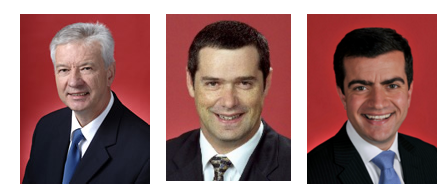
Three Labor Senators to watch on the committee: Doug Cameron, Stephen Conroy, Sam Dastyari
Among those likes to take an interest are Sam Dastyari, dubbed somewhat unkindly by the AFR “as the minister for show business”, former minister for communications Stephen Conroy and left of centre Labor MP Doug Cameron.
Which media mogul witnesses it calls and the testimony that the committee, chaired by Coalition MP Senator Linda Reynolds, hears will certainly make for interesting viewing and could well decide the fate of the legislation.
From there the committee will report at the end of Budget week. Now, if Malcolm Turnbull does as some are tipping and calls a double dissolution on the back of the Budget then the media reform legislation will fall by the wayside and will need to resubmitted in the next parliament.
Now this is not without consequence for the regional TV networks many of whom have looming affiliate negotiations with their sister stations (but we’ll return to this point later) and it is also worth noting the parliamentary calendar only has the Senate sitting for two weeks (the weeks of June 20 and June 27) before the affiliate negotiations come up giving the government a tight window to get the laws through, assuming there is no double dissolution.
- Can the government get support for the media reform package? Where are Labor, the greens and the Senate cross-bench?
Right now the main political party opposing the media reforms are the Greens.

Ludlam: technology being used as a reason to reform.
Greens media and communications policy spokesman Senator Scott Ludlam last week issued a statement saying:
“It’s too easy for the government to say that the internet has negated the need for any diversity protections in our media ownership framework, but the dominant players in print and broadcast media have successfully used their incumbency to cement their place at the top of Australia’s online news media space as well.”
Ludlam took aim at the NBN and concerns about media diversity saying: “Technological advances in streaming services and the like are being used as a reason to abolish the reach rule, but this only makes sense if there is a decent national broadband network to deliver these services.”
Labor on the other hand seems more divided. Its shadow communications minister Jason Clare has kept his options open and backed the abolition of reach rule but has sat on the fence on the issue of two out of three.
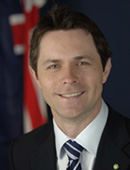
Clare: arguments on both sides.
Speaking last week to Sky News, Clare told reporter Laura Jayes:
“Absolutely, I’d call it (the reach rule) pretty non-controversial. We proposed that when we were in Government three years ago. The other proposed change is the two-out-of-three rule, it’s more controversial.
“There are good arguments in favour of keeping it and also good arguments in favour getting rid of it and what I’ve said is lets weigh up both sides of that argument by going through the proper parliamentary committee process and the Minister has indicated that that will happen.”
So Labor will keep its options open and Clare is thought to be open to the media reform others such as former minister for communications Conroy who are thought to be pushing for the party to oppose the law, particularly if it is seen to benefit News Corp through its indirect stakes in Ten, through Foxtel.
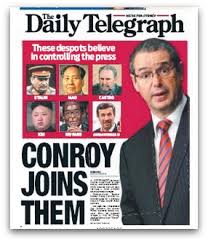
One of the front pages News Corp ran attacking Conroy back in 2013.
Conroy is described as having a “toxic” relationship with News Corp and for those who don’t remember why, just think back to 2013 when the Gillard government proposed a series of media reforms that would have included the creation of Public Interest Media Advocate, which would have overseen print watchdog The Australian Press Council.
News Corp Australia fiercely opposed those laws and attacked Conroy personally over them. Conroy is on the way out and may want to settle the score while Clare on the other hand is ambitious, seeing himself as potential future Labor leader, and is likely to be more practical about the reforms.
- What are the potential risks to the legislation passing? What pressures are they to pass the laws?
However, if Labor and the Greens both oppose the media reforms that will force the government to deal with the crossbench senators, many of whom are angry at the Coalition over proposed changes to the Senate which make it unlikely many of them will be re-elected again.
As a number of media executives have observed to Mumbrella, in recent weeks, the whole media reform package may come down to “how shitty” the crossbench is with Turnbull and the Coalition government.
Communications Minister Fifield is also manager of government business in the Senate and therefore deals regularly with what is a ragtag bunch of Senators.
Some such as Palmer United Senator Dio Wang, Family First Bob Day and Liberal Democratic Senator David Leyonhjelm are thought to be broadly supportive of the laws, although Day was yesterday telling Fairfax he had not made a decision.

Senators Wang, Leyonhjelm, Day, are thought to be broadly supportive of media reform
But for the laws to pass the government needs six of the eight Senators to support the reforms and getting the likes of former Palmer United Senators Jackie Lambie, Glen Lazarus and Motoring Enthusiasts party Ricky Muir and former Democratic Labor Party member John Madigan to support a law which benefits billionaires like Bruce Gordon may be much more tricky.

Can the government convince the likes of Xenophon, Lambie, Lazarus?
Meanwhile independent Nick Xenophon may be convinced but will likely want to horse-trade in return for benefits to his own State of South Australia.
You can expected the likes of Prime Media, WIN Corp and Southern Cross Austereo to be very vocal in the coming months, pressuring the Senate to allow them to merge ahead of the affiliate negotiations.
Indeed they will cite recent financial results like Prime Media’s 17.1% decline in its net profit in its most recent half yearly results, to pressure politicians to act.
- If the legislation passes what happens? Who might merge with who?
Predicting who will merge with who is much more problematic.
 What we do know is that both Nine and Ten are looking at the options of mergers with their relative affiliates – the challenge in predicting who will go where is that the likes of Southern Cross Austereo and WIN have deals with both.
What we do know is that both Nine and Ten are looking at the options of mergers with their relative affiliates – the challenge in predicting who will go where is that the likes of Southern Cross Austereo and WIN have deals with both.
Also billionaire Bruce Gordon has cleverly positioned himself with key shareholdings in both Nine (where he is the biggest shareholder) and Ten in an effort to ensure he is at the centre of any negotiations. Add to this the drama of his current legal action against Nine over 9Now and it all makes for an interesting and fluid dynamic.
For those interested in the landscape of who owns what and what’s at play, see the infographics on media ownership at media watchdog the Australian Communications and Media Authority (ACMA).
Southern Cross Austereo is currently in a exclusive negotiating period with Ten but that doesn’t mean it won’t end up in a deal with Nine. Likewise, WIN could still end up in a deal with Ten.
 Prime Media is likely to be the one left without a dance partner as its sister station SevenWest Media has expressed no interest in a merger, instead focusing on licence fee reductions. But that hasn’t stopped Prime from hiring Citigroup to advise them on potential merger partners.
Prime Media is likely to be the one left without a dance partner as its sister station SevenWest Media has expressed no interest in a merger, instead focusing on licence fee reductions. But that hasn’t stopped Prime from hiring Citigroup to advise them on potential merger partners.
- Where do News Corp and Fairfax come into the mix?
In the cut-and-thrust of the debate many, particularly on the left, will be asking what News Corp and its chairman Rupert Murdoch get out of these reforms?
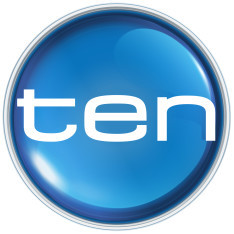
Could the new laws potentially put a News Corp – Ten deal in play?
By abolishing the ‘two out of three rule’ that prevents no person or company controlling more than two out of the three traditional media platforms this could potentially open the door to a Ten/Foxtel merger subject only to 5/4 media voices rules (which could be avoided if Nova sells off a couple of stations).
When ACMA approved the Foxtel/Ten deal last year, it found: An “unacceptable three-way control situation” would result in the four licence areas where Mr Murdoch is already in a position to control the Nova commercial radio broadcasting licences and the News Corporation-associated newspapers.
“However, the ACMA considered that, while Mr Murdoch was in a position to exert influence on Ten, that level of influence fell short of ‘control’ as prescribed by the BSA.”
With the ‘two out three rule’ eliminated, the Murdochs and News Corp could again take more of a role in Ten and it would not be surprising if the Labor Senators on the communications committee choose to look at this issue in the coming weeks.
But there are also interesting machinations happening on the Fairfax side of the equation.
The idea of a Fairfax-Nine merger has been floated repeatedly in recent years and while former Nine CEO David Gyngell was insistent that there would be no merger while Fairfax was “still in print” there’s the potential that its new management team could be more open to the idea.
 It’s certainly interesting that the likes of recently departed Nine chief financial officer Simon Kelly suddenly came out and backed the idea of a Nine-Fairfax-Southern Cross Austereo “mega merger.”
It’s certainly interesting that the likes of recently departed Nine chief financial officer Simon Kelly suddenly came out and backed the idea of a Nine-Fairfax-Southern Cross Austereo “mega merger.”
Mumbrella understands that Fairfax has been quietly lobbying for the media reforms to pass, particularly with Labor. Indeed some see Fairfax’s support as pivotal for the package to Parliament.
How realistic this proposal is remains to be seen, and it is interesting to see how quickly on Friday Fairfax management rejected reports in The Australian that it may have been behind the purchase of a parcel of shares at Nine.
What is clear, however, is that the two companies have developed a close working relationship through streaming service Stan, and with many wondering about a possible closer relationship between News Corp and Ten this has the potential to continue to fuel speculation about a similar Nine/Fairfax tie up.
Well simply put, no. The policy agenda of the major TV networks is broader.
The likes of Foxtel will continue to push Canberra to curb the anti-siphoning list which governs which sports must be shown on free-to-air TV; however, consecutive governments have shown little desire to curb the list and risk voter anger in the process.
For the free-to-air networks their other big agenda is licence fee reductions on the $153m they paid the government in annual fees for the right to use the spectrum.
The TV industry argues these fees were established in an era when they had a monopoly on broadcast, but today YouTube, Netflix and the likes have undermined that dominance – therefore the licence fees should be reduced and/or abolished.
Communications Minister Fifield signalled the Coalition was open to this last week, describing it as a “super profits tax” and that there will likely be relief in the upcoming budget.
As for the rest of the broad agenda they will also continue to beat the drum on the issue of tax – reminding government that when it comes to tax paid by the likes of YouTube’s owner Google, and Netflix it is “not a level playing field”.
However, any action on this front will likely be tied to wholesale corporate tax reform – something that doesn’t immediately appear to be on the agenda.
The coming months are likely to see the current media reform package consume the government and media executives’ agenda. A chess board is set but predicting precisely how the media reform game will play out is, at this stage, difficult.
The only thing we do know is if the whole game is allowed to play out there is likely to be a few less pieces on the board as others subsume and merge them, in a quest for victory.
Nic Christensen is the media and technology editor of Mumbrella



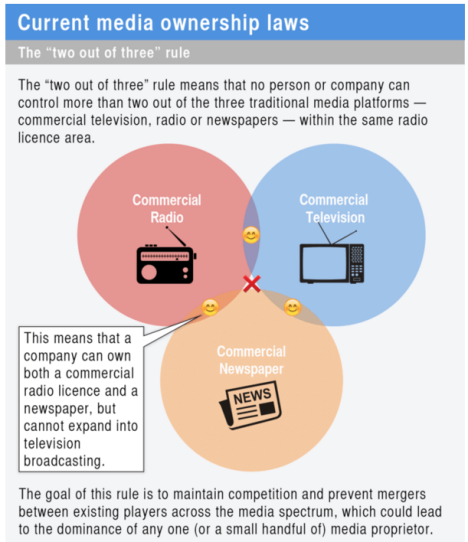
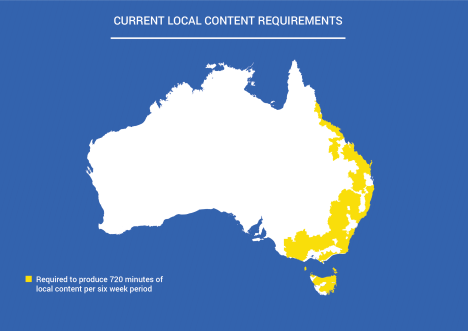
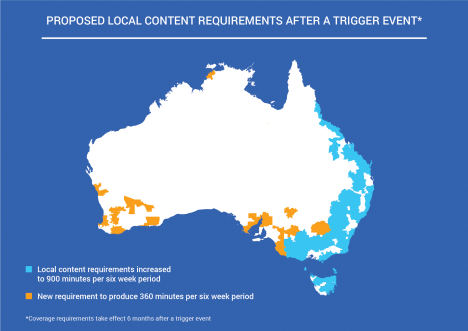
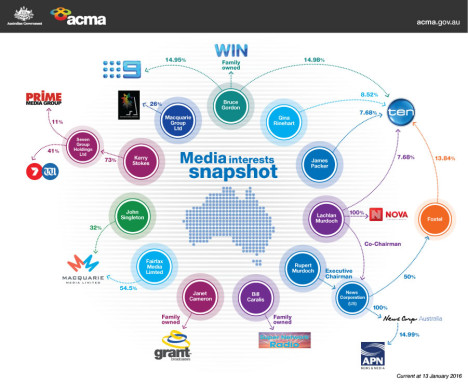

‘This is the most factitious day of my life’ R Murdoch. [US citizen] Statement.
User ID not verified.